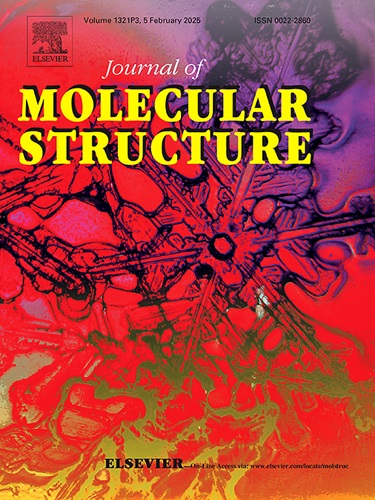新型抗H5N1和SARS-CoV-2抗病毒药物1,2,3-三唑clickamers的鉴定和纳米制剂研究
IF 4
2区 化学
Q2 CHEMISTRY, PHYSICAL
引用次数: 0
摘要
我们用标准的点击化学方法制备并表征了一系列1,2,3-三唑点击分子。用Cu(I)离子催化双叠氮化合物与2-乙基吡嗪或乙基苯原位还原CuSO4,以高收率(80-90%)制得上述化合物。光谱分析证实了合成化合物的化学结构。抗病毒评价显示,化合物8、9和10对SARS-CoV-2具有显著的抗病毒作用,而化合物7和9对H5N1具有较强的抗病毒活性。化合物8被包裹在粒径为87.27±0.9 nm的乙基纤维素纳米颗粒(EC-NPs)中。纳米制剂表现为负zeta电位,确保了稳定性并提高了细胞渗透性。化合物8在EC-NPs中的释放受到控制并随时间持续,6小时后达到38.72%,12小时后达到88.16%。在对SARS-CoV-2进行抗病毒筛选时,化合物8的IC50值从32.26µM降至15.40µM,显示出明显的抗病毒活性。分子对接实验表明,化合物8与SARS-CoV-2关键蛋白之间存在较强的相互作用。本研究开发的1,2,3-三唑类药物为抗病毒治疗领域做出了重大贡献,并为其临床应用铺平了道路。本文章由计算机程序翻译,如有差异,请以英文原文为准。

Identification and nanoformulation study of novel 1,2,3-triazole clickamers as potential antivirals against H5N1 and SARS-CoV-2
We have prepared and characterized a series of 1,2,3-triazole clickamers using the standard click chemistry approach. The compounds were obtained in high yields (80-90%) by the reaction of diazides with 2-ethynylpyrazine or ethynylbenzene catalyzed by Cu(I) ions via in situ reduction of CuSO4. Spectroscopic analyses confirmed the chemical structures of the synthesized compounds. The antiviral evaluation revealed significant efficacy of compounds 8, 9, and 10 against SARS-CoV-2, while compounds 7 and 9 showed strong activity against H5N1. Compound 8, selected for further study, was encapsulated in ethyl cellulose nanoparticles (EC-NPs) with a size of 87.27 ± 0.9 nm. The nanoformulation showed negative zeta potential, ensuring stability and improved cell penetration. The release of compound 8 from the EC-NPs was controlled and sustained over time, reaching 38.72% after six hours and 88.16% after 12 hours. The nanoformulation showed significant antiviral activity and reduced the IC50 value of compound 8 from 32.26 µM to 15.40 µM in the case of antiviral screening against SARS-CoV-2. Molecular docking experiments showed strong interactions between compound 8 and key proteins of SARS-CoV-2. The 1,2,3-triazoles developed in this study offer a significant contribution to the field of antiviral therapeutics and pave the way for promising clinical applications.
求助全文
通过发布文献求助,成功后即可免费获取论文全文。
去求助
来源期刊

Journal of Molecular Structure
化学-物理化学
CiteScore
7.10
自引率
15.80%
发文量
2384
审稿时长
45 days
期刊介绍:
The Journal of Molecular Structure is dedicated to the publication of full-length articles and review papers, providing important new structural information on all types of chemical species including:
• Stable and unstable molecules in all types of environments (vapour, molecular beam, liquid, solution, liquid crystal, solid state, matrix-isolated, surface-absorbed etc.)
• Chemical intermediates
• Molecules in excited states
• Biological molecules
• Polymers.
The methods used may include any combination of spectroscopic and non-spectroscopic techniques, for example:
• Infrared spectroscopy (mid, far, near)
• Raman spectroscopy and non-linear Raman methods (CARS, etc.)
• Electronic absorption spectroscopy
• Optical rotatory dispersion and circular dichroism
• Fluorescence and phosphorescence techniques
• Electron spectroscopies (PES, XPS), EXAFS, etc.
• Microwave spectroscopy
• Electron diffraction
• NMR and ESR spectroscopies
• Mössbauer spectroscopy
• X-ray crystallography
• Charge Density Analyses
• Computational Studies (supplementing experimental methods)
We encourage publications combining theoretical and experimental approaches. The structural insights gained by the studies should be correlated with the properties, activity and/ or reactivity of the molecule under investigation and the relevance of this molecule and its implications should be discussed.
 求助内容:
求助内容: 应助结果提醒方式:
应助结果提醒方式:


